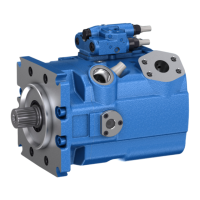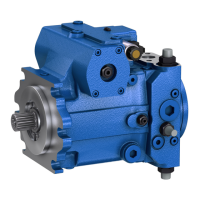About this product 21/68
RE 93100-01-B/2019-09-10, A20V(L)O Series 1, Bosch Rexroth AG
1
2
4
6
7
5
8
9
10
11121516
17
7 8
6
4
2
5 11 12 15 1614
14
13 13
Fig. 3: Layout of A20VO, size 520
1 Drive shaft
2 Retaining plate
3 Opposed piston
4 Swivel angle indicator
5 Suction side
6 Pilot control valve
7 Control valve
8 Control plate
(distributor plate)
9 Suction port
10 High-pressure side
11 Cylinder
12 Piston
13 Stroking piston
14 Slipper pad
15 Sliding disc
16 Cradle / swashplate
17 Through drive
5.2.2 Functional description
Torque and rotational speed are applied to the drive shaft(1) by a drive motor. The
cylinder(11) ispicked up and turned by the splines ofthe drive shaft. With every
revolution, the pistons(12) complete a stroke in the cylinder bores, the size of which
depends on the pitch of the cradle(16). The slipper pads(14) are held on with the
pistons and guided along the glide surface of the cradle and/or the sliding disc(15)
by the retaining plate(2). The pitch oftheswashplate during arevolution causes
each piston tomove over thebottom and top dead centers and back toits initial
position. During this sequence, hydraulic fluid isfed inand drained out through the
two control slots inthe control plate(8) according todisplacement. On the suction
side(5) hydraulic fluid flows into the piston chamber asthe piston recedes. At the
same time, onthe high-pressure side (10) the hydraulic fluid ispushed out ofthe
cylinder chamber into the hydraulic system by the pistons.
The swivel angle of the cradle(16) is continuously adjustable. Controlling
theswashplate swivel angle changes thepiston stroke and, therefore,
thedisplacement. The swivel angle iscontrolled hydraulically bymeans
ofthestroking piston. Increasing theswivel angle increases thedisplacement;
reducing theangle reduces displacement accordingly.
Various control devices are available depending onrequirements. Information
about this can befound indata sheet 93100.
Pump
Control

